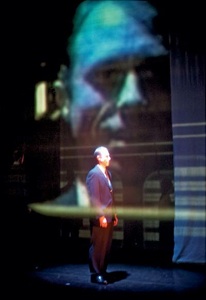Reading Bury Place Papers, the selection of essays written by Frank Kermode for the London Review of Books, I stumble across this passage, not from Kermode himself but from Michael Wood’s introduction to the volume:
Kermode is not Housman and not a diviner. But he does devote much exquisite intelligence to matters of divinations - even and especially of secular affairs. He would like us to believe we could do without such obliquities. He is touched and amused by the fact that Housman appears to have thought that both laughing and crying were legitimate critical responses to poetry. He is drawn to the thought of a shared, unpuzzling world even if he sees that world as a new fragmented and perhaps never really tenable historical fantasy.
I am startled and bewildered by the
phrase ‘he is touched and amused by the fact that Housman appears to
have thought laughing and crying were legitimate critical responses to
poetry’. The claim reminds me of one of the key moments of New
Criticism, Wimsatt and Beardsley’s ‘The Affective Fallacy’, the less
well-known and less successful brother to ‘The Intentional Fallacy’.
Wimsatt and Beardsley argue that a persistent error in critical
responses to literature is to confuse one’s physiological reactions to
literature with assessments of its objective features. By chance, the
director Matthew Warchus gives a good example of the kind of thing they
are reacting on the current Guardian website against when he says that
he judges the quality of plays by ‘the tingle factor’ he feels when he reads them.
Kermode wasn’t a New Critic. He started
his career after their star had waned though there were Leavisite
elements to his early work and Leavis, though really not a New Critic
(they cared nothing for morality), had some affinities with them in
their close reading of things. Kermode’s success came with some
well-regarded books in the sixties, notably the brilliant The Sense of
an Ending, but this reputation was sharpened and enriched by his
enthusiastic welcome of continental theory in the 1970s (he nobly
resigned from Cambridge in 1982 over the MacCabe Affair)
and in some ways that would suggest a turning away from New Criticism
and all that stuff. But, certainly in North America, deconstruction
entered in as a kind of modification - radical, to be sure - of close
reading: a reading so close that it distorted the thing read (like the
uncertainty principle extended to literature).
So what is he saying here? That laughing
and crying are no sort of guide at all? Well, let’s deal with the
obvious supports for this idea first. There are strange people who laugh
perversely as things most people would cry at and vice versa. And as
soon as I say that I think, literary criticism isn’t a referendum: maybe
for us, as for Ibsen’s Dr Stockmann, the minority is a better guide.
So, Wimsatt and Beardsley suggest, let’s ignore what people happen to do
and look at the objective features of the thing itself.
I guess I’m thinking about laughter a lot, thinking about the complexity of laughter in the theatre
and the long history of objections to laughter. Laughter is often
disregarded, marginalised, dismissed, condemned and censored. There’s
something dangerous and trivialising, it seems, about laughter.
In the theatre, this careful paring away
of laughter from art is uncomfortable, because the thing itself is
affected by the reaction. If you’re performing What the Butler Saw
and people aren’t laughing, the performance will usually suffer. The
performance is about generating laughter; if they laugh, it goes well;
if they don’t laugh, it doesn’t. And similarly if people are guffawing
through Elektra, you may not be doing it
right (okay unless you’ve decided to do a comedy production, sure sure).
And when you get the reaction you’re aiming for, hushed, taut silence
in a tragic scene, rolling waves of hysterical laughter in a farce, the
actors lock into in, find the right timing, know how to ‘play’ an
audience, and the performance therefore alters to play to its audience.
What would Wimsatt and Beardsley say?
They might say that regardless of the response we still should look at
the performance itself - whysoever the actors performed the way they
did, we should still look at the performance. They might insist that the
accidents of physiology are insignificant: some people cry, some people
just feel sad inside, and one is not more meaningful than the other.
Which is true, except not quite for
laughter. In performing a comedy, you’re not trying to get people to
appreciate that it’s funny (at least not only that); you’re trying to
get them to laugh out loud. It’s the laugh out loud that involves timing
and rhythm and precision. Things can be vaguely funny if very
approximate, but you’re unlikely to laugh out loud. If everyone is
smiling inside, the comedy feels dead. And, more importantly, the
experience of comedy can sometimes be enjoyment of everyone else’s
laughter, surfing on their laughter, enjoying being part of an audience
giving out those great shouts of laughter that wonderful comedy can
generate. The show is not just what’s on stage; it’s also the sound of
the laughter.
I saw Oklahoma!
at the National Theatre a decade or so ago. Musicals are, in a sense,
theatrical pleasure-machines, construction designed to produce sheer
delight in their audiences. I sat next to an Australian woman who told
me before the lights went down that she’d been looking forward to the
show for months, that Oklahoma! was one of
her favourites, that she had the film soundtrack as a girl, that she
loved all the songs and that I’d be lucky if she didn’t sing along.
She was true to her word. As soon as the
dialogue in a scene turned towards the matter of a song (‘How you gonna
take me to the box social, Curly?’) she began gurgling with pleasurable
anticipation and as the song started she had locked into its rhythm,
bouncing slightly in her seat and mouthing the words. Perhaps in another
mood, this would have been rather irritating, but I was looking for the
simpler pleasures of the musical (I was determinedly resisting Trevor
Nunn’s attempt to make Oklahoma! into an
important statement about the human condition) and that woman became a
totem of the pleasures of the musical; her joy was infectious and it was
part of my enjoyment of the show. The pleasures of the production were
sharpened and focused and enhanced by the co-presence of this woman.
Part of the experience and less without it.
And then I am struck that Kermode was supposedly ‘touched and amused’ by this belief of Housman’s, that Wood chooses to describe his response in terms of affect rather than critical appraisal of its objective features.





![photo[1].jpg](https://images.squarespace-cdn.com/content/v1/513c543ce4b0abff73bc0a82/1362919072201-PZO854G4SEB794DVOEI8/photo%5B1%5D.jpg)
